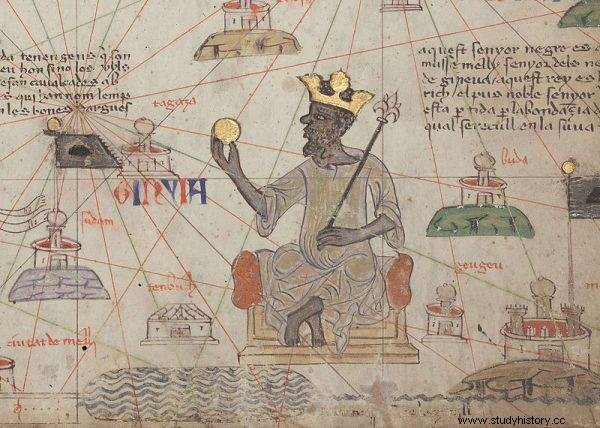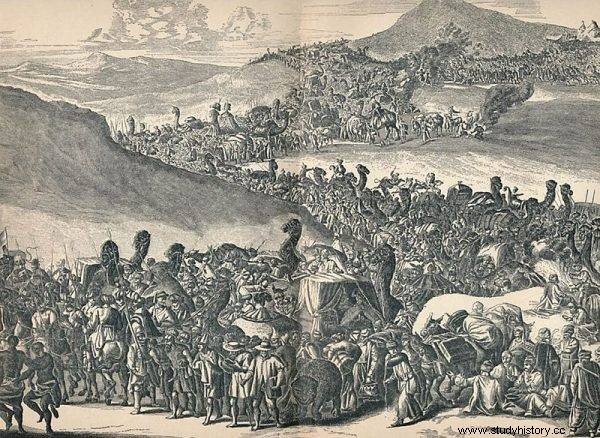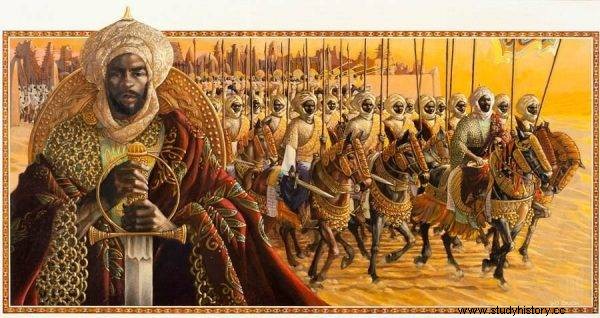Some say his fortune today would be around $ 450 billion, others say there are no numbers to describe Mansa Musa's wealth.
Who was the richest man in history, outclassing today's multi-millionaires? Mansa Musa was born in 1280 into the royal family. Before him, Mali was ruled by Musa's older brother, Mansa Abu-Bakr who abdicated in 1312. He made a trip ... and never came back. Historians speculate that may have made an unsuccessful attempt to cross the Atlantic Ocean . If the Syrian scholar Shibab al-Umari is to be believed, Abu-Bakr was truly obsessed with crossing the great waters. He took 2,000 ships and thousands of people on the expedition. Did they reach the coast of South America? We will probably never find out. Anyway, Mansa Musa inherited the kingdom of Mali from his brother.
Splendor but not fame
He ruled from 1312 to 1337. Already at the beginning, he managed to significantly expand the borders of Mali. He conquered as many as 24 cities - including the rich Timbuktu. Collectively, his country covered an area of what is now Mali and Senegal, Gambia, much of Guinea, and Guinea-Bissau, Mauritania, Niger, Burkina Faso and Sierra-Leone.

Mansa Musa ruled from 1312 to 1337.
The king taxed the transportation of metals and luxury goods through his state. Such an impressive piece of land also provided Musa with many valuable resources, such as gold and salt, over which he had total control . It is estimated that during the rule of the richest man in Mali's history owned half of all gold in Africa . And although the king of Mali met with his subjects and guests armed with pure gold weapons, seated on a throne carried by thirty slaves; although he never spoke to petitioners directly, instead conveying words through the mouths of officials - he was relatively little known abroad. The desire to gain publicity in the wide world pushed him to act - in 1324 he went to Mecca.
Too much pocket money
The destination was about 5,000 kilometers away, so Musa had to prepare properly. Depending on the sources, he could take with him an entourage of 10,000 to 60,000 and an allowance of 12,000 slaves. The difficult road through the Sahara desert and Egypt killed a third of the people walking in the mighty caravan. " The king took the main wife, Inari Kanuté, with him, and she in turn took hundreds of servants and slaves "- writes David C. Conrad in the book" Empires of Medieval West Africa ". - " There were also merchants, soldiers protecting the caravan (...), thousands of camels and donkeys laden with food, water and other resources ”.

Mansa Musa with his retinue on his way to Mecca
He stayed in Cairo, which was the capital of the Mamluks at the time, for three months. During this time, he spent such exorbitant sums there that he created blast inflation. In doing so, he plunged this area into a ten-year crisis. He allegedly gave the sultan himself a gift in the form of 40,000 gold coins. Funnily enough, Musa was throwing gold around so eagerly that he… spent it all . It didn't worry him too much, however. There were countless mountains of gold waiting for him at home. So he borrowed money for the onward journey without fear. Other historians say that by returning to Mali, he understood the enormity of the economic losses his gold caused. By borrowing, he tried to remove some of the expensive metal from circulation and thus save Cairo.
Estimates say that King Musa's passage through the Middle East resulted in economic losses equivalent to a modern day sum of $ 1.5 billion.
African El Dorado
Mansa Musa's extravagance could arouse various emotions. But surely the ruler has achieved his goal:fame. The world has heard about Mali and its wealth. The word about Musa reached Christian Europe. His image was found in 1375 in the "Catalan Atlas" drawn up in Spain. The king was of course depicted there on a magnificent throne and with a gold coin in his hand.
Mansa Musa's expedition also had a positive effect on the economic situation of Mali. Timbuktu flourished, becoming a cosmopolitan meeting place for poets, scholars and artists from Africa and the Middle East . The "African El Dorado" patch stuck to Timbuktu for many years - it lasted until the 19th century!

Musa's net worth would be around $ 450 billion today.
King Mali did not spare any money for the services of his subjects. The architect Abu Es Haq es Saheli, brought from Mecca, who designed the Djinguereber mosque, received a payment of 200 kilograms of gold, that is, today - several million dollars. Mansa Musa has invested in education, art and architecture . He built schools, libraries and mosques in Mali. People from distant corners of the world came to study at the famous Sankore Madras University.
Musa died at the age of 57, and the kingdom of Mali was inherited by his sons. Unfortunately, they were unable to keep it fully. They soon smashed their father's empire to pieces. The subsequent appearance of people from Europe in this region sealed the fate of what was left of the mighty Mali. But the memory of the richest man of all time survives: Musa was on the list of the 25 richest people in history . According to Brian Warner, journalist and founder of CelebrityNetWorth, Musa's fortune would be around $ 450 billion today.
Bibliography:
- Conrad, D., C, Empires of Medieval West Africa . Ghana, Mali, and Songhay, Chelsea House, 2010.
- Mohamud, N., Is Mansa Musa the richest man who ever lived ?, www.bbc.com (access:24/03/2022).
- Niane, D., T., Recherches sur l'Empire du Mali au Moyen Age . Recherches Africaines, 1959.
- Silady, A., Four People Who Single-handedly Caused Economic Crises, smartasset.com (accessed:24/03/2022).
